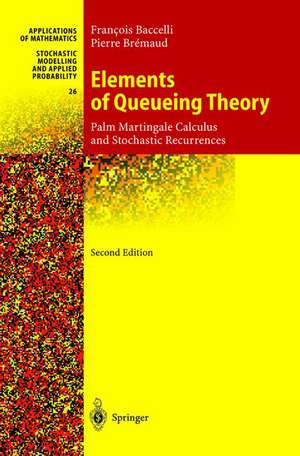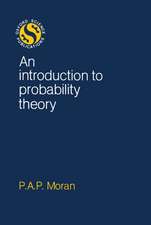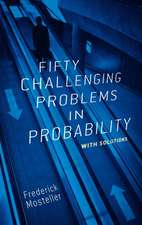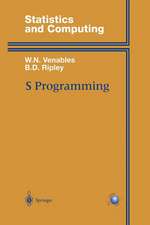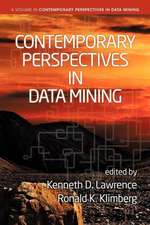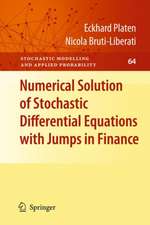Elements of Queueing Theory: Palm Martingale Calculus and Stochastic Recurrences: Stochastic Modelling and Applied Probability, cartea 26
Autor Francois Baccelli, Pierre Bremauden Limba Engleză Hardback – 10 dec 2002
| Toate formatele și edițiile | Preț | Express |
|---|---|---|
| Paperback (1) | 643.16 lei 43-57 zile | |
| Springer Berlin, Heidelberg – 8 dec 2010 | 643.16 lei 43-57 zile | |
| Hardback (1) | 648.24 lei 43-57 zile | |
| Springer Berlin, Heidelberg – 10 dec 2002 | 648.24 lei 43-57 zile |
Din seria Stochastic Modelling and Applied Probability
- 17%
 Preț: 464.63 lei
Preț: 464.63 lei - 18%
 Preț: 805.44 lei
Preț: 805.44 lei - 18%
 Preț: 1110.72 lei
Preț: 1110.72 lei - 18%
 Preț: 947.35 lei
Preț: 947.35 lei -
 Preț: 390.84 lei
Preț: 390.84 lei - 18%
 Preț: 952.40 lei
Preț: 952.40 lei - 15%
 Preț: 648.56 lei
Preț: 648.56 lei - 18%
 Preț: 951.91 lei
Preț: 951.91 lei - 15%
 Preț: 637.13 lei
Preț: 637.13 lei - 18%
 Preț: 793.63 lei
Preț: 793.63 lei -
 Preț: 391.02 lei
Preț: 391.02 lei -
 Preț: 401.42 lei
Preț: 401.42 lei - 15%
 Preț: 639.08 lei
Preț: 639.08 lei - 18%
 Preț: 733.33 lei
Preț: 733.33 lei - 18%
 Preț: 785.11 lei
Preț: 785.11 lei - 15%
 Preț: 593.42 lei
Preț: 593.42 lei - 18%
 Preț: 1114.96 lei
Preț: 1114.96 lei - 15%
 Preț: 643.16 lei
Preț: 643.16 lei -
 Preț: 390.63 lei
Preț: 390.63 lei - 15%
 Preț: 645.60 lei
Preț: 645.60 lei - 15%
 Preț: 641.71 lei
Preț: 641.71 lei - 18%
 Preț: 954.62 lei
Preț: 954.62 lei - 15%
 Preț: 645.14 lei
Preț: 645.14 lei - 18%
 Preț: 947.50 lei
Preț: 947.50 lei - 18%
 Preț: 804.96 lei
Preț: 804.96 lei - 15%
 Preț: 644.63 lei
Preț: 644.63 lei - 20%
 Preț: 469.59 lei
Preț: 469.59 lei - 20%
 Preț: 581.39 lei
Preț: 581.39 lei
Preț: 648.24 lei
Preț vechi: 762.64 lei
-15% Nou
Puncte Express: 972
Preț estimativ în valută:
124.08€ • 134.82$ • 104.29£
124.08€ • 134.82$ • 104.29£
Carte tipărită la comandă
Livrare economică 21 aprilie-05 mai
Preluare comenzi: 021 569.72.76
Specificații
ISBN-13: 9783540660880
ISBN-10: 3540660887
Pagini: 334
Ilustrații: XIV, 334 p.
Dimensiuni: 156 x 234 x 24 mm
Greutate: 0.64 kg
Ediția:2nd ed. 2003
Editura: Springer Berlin, Heidelberg
Colecția Springer
Seria Stochastic Modelling and Applied Probability
Locul publicării:Berlin, Heidelberg, Germany
ISBN-10: 3540660887
Pagini: 334
Ilustrații: XIV, 334 p.
Dimensiuni: 156 x 234 x 24 mm
Greutate: 0.64 kg
Ediția:2nd ed. 2003
Editura: Springer Berlin, Heidelberg
Colecția Springer
Seria Stochastic Modelling and Applied Probability
Locul publicării:Berlin, Heidelberg, Germany
Public țintă
ResearchCuprins
The Palm Calculus of Point Processes.- Stationarity and Coupling.- Formulas.- Stochastic Ordering of Queues.
Recenzii
From the reviews:
No doubt this textbook will further convince the queueing modeller of the essential importance of point processes and martingale technology.
Paul Embrechts. Short Book Reviews, December 2003
"This book is intended for graduate students and researchers in queuing theory and applied probability. … Overall this is a well-written text that provides an interesting alternative to more classical approaches. … The results on stability and other qualitative properties of queues provided by this framework are very general and show the power of this modern approach." (Charles Knessl, SIAM Reviews, Vol. 47 (4), 2005)
"The mathematical treatment in the book is careful and thorough enough that it can be understood by anyone with a reasonable preparation in measure-theoretic probability. … A particularly useful feature … is the addition of exercises and problems … . The strength of this book is the careful and rigorous treatment of the framework and of the mathematical tools that unify and derive classical results and formulae for a number of queuing networks. It can definitely be used as a text at an advanced level." (S. Ramakrishnan, Sankhya, Vol. 66 (2), 2004)
"No doubt this textbook will further convince the queuing modeller of the essential importance of point process and martingale technology. Besides providing an elegant and broad theoretical foundation, the general results obtained allow for straightforward explicit calculations … . The theory presented is non-trivial … those who master it will be in the possession of a powerful tool with considerable potential for applied work. … I take pleasure in recommending this text very highly." (P.A.L. Embrechts, Short Book Reviews, Vol. 23 (3), 2003)
"I am convinced that this second edition will be welcomed in the same way by those who need a source for (comparable) easy access to point process methodology. It is well written, a clearpresentation of the topics … . I find its first edition useful as a reference and a source for new material. And in my view the second edition is clearly an enhanced revision of it. … the book will be welcomed by everyone interested in the field." (Hans Daduna, Statistical Papers, Vol. 44 (3), 2003)
No doubt this textbook will further convince the queueing modeller of the essential importance of point processes and martingale technology.
Paul Embrechts. Short Book Reviews, December 2003
"This book is intended for graduate students and researchers in queuing theory and applied probability. … Overall this is a well-written text that provides an interesting alternative to more classical approaches. … The results on stability and other qualitative properties of queues provided by this framework are very general and show the power of this modern approach." (Charles Knessl, SIAM Reviews, Vol. 47 (4), 2005)
"The mathematical treatment in the book is careful and thorough enough that it can be understood by anyone with a reasonable preparation in measure-theoretic probability. … A particularly useful feature … is the addition of exercises and problems … . The strength of this book is the careful and rigorous treatment of the framework and of the mathematical tools that unify and derive classical results and formulae for a number of queuing networks. It can definitely be used as a text at an advanced level." (S. Ramakrishnan, Sankhya, Vol. 66 (2), 2004)
"No doubt this textbook will further convince the queuing modeller of the essential importance of point process and martingale technology. Besides providing an elegant and broad theoretical foundation, the general results obtained allow for straightforward explicit calculations … . The theory presented is non-trivial … those who master it will be in the possession of a powerful tool with considerable potential for applied work. … I take pleasure in recommending this text very highly." (P.A.L. Embrechts, Short Book Reviews, Vol. 23 (3), 2003)
"I am convinced that this second edition will be welcomed in the same way by those who need a source for (comparable) easy access to point process methodology. It is well written, a clearpresentation of the topics … . I find its first edition useful as a reference and a source for new material. And in my view the second edition is clearly an enhanced revision of it. … the book will be welcomed by everyone interested in the field." (Hans Daduna, Statistical Papers, Vol. 44 (3), 2003)
Textul de pe ultima copertă
The Palm theory and the Loynes theory of stationary systems are the two pillars of the modern approach to queuing. This book, presenting the mathematical foundations of the theory of stationary queuing systems, contains a thorough treatment of both of these.
This approach helps to clarify the picture, in that it separates the task of obtaining the key system formulas from that of proving convergence to a stationary state and computing its law.
The theory is constantly illustrated by classical results and models: Pollaczek-Khintchin and Tacacs formulas, Jackson and Gordon-Newell networks, multiserver queues, blocking queues, loss systems etc., but it also contains recent and significant examples, where the tools developed turn out to be indispensable.
Several other mathematical tools which are useful within this approach are also presented, such as the martingale calculus for point processes, or stochastic ordering for stationary recurrences.
This thoroughly revised second edition contains substantial additions - in particular, exercises and their solutions - rendering this now classic reference suitable for use as a textbook.
This approach helps to clarify the picture, in that it separates the task of obtaining the key system formulas from that of proving convergence to a stationary state and computing its law.
The theory is constantly illustrated by classical results and models: Pollaczek-Khintchin and Tacacs formulas, Jackson and Gordon-Newell networks, multiserver queues, blocking queues, loss systems etc., but it also contains recent and significant examples, where the tools developed turn out to be indispensable.
Several other mathematical tools which are useful within this approach are also presented, such as the martingale calculus for point processes, or stochastic ordering for stationary recurrences.
This thoroughly revised second edition contains substantial additions - in particular, exercises and their solutions - rendering this now classic reference suitable for use as a textbook.
Caracteristici
The authors are among the foremost researchers working in this field As a reference work in the field, this book responds to a real need The second edition can now be used also as a textbook Includes supplementary material: sn.pub/extras
